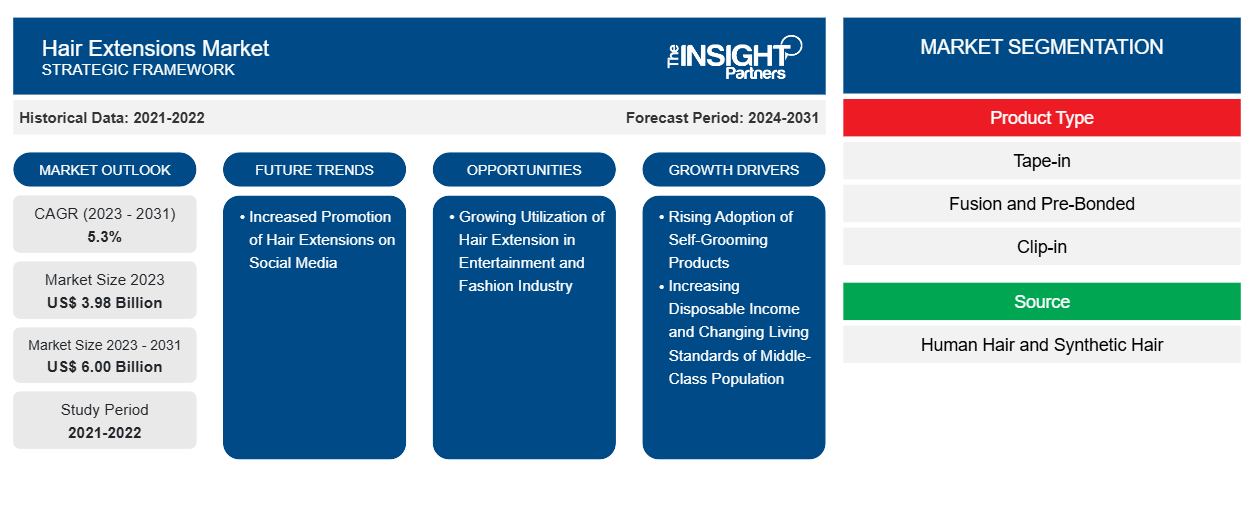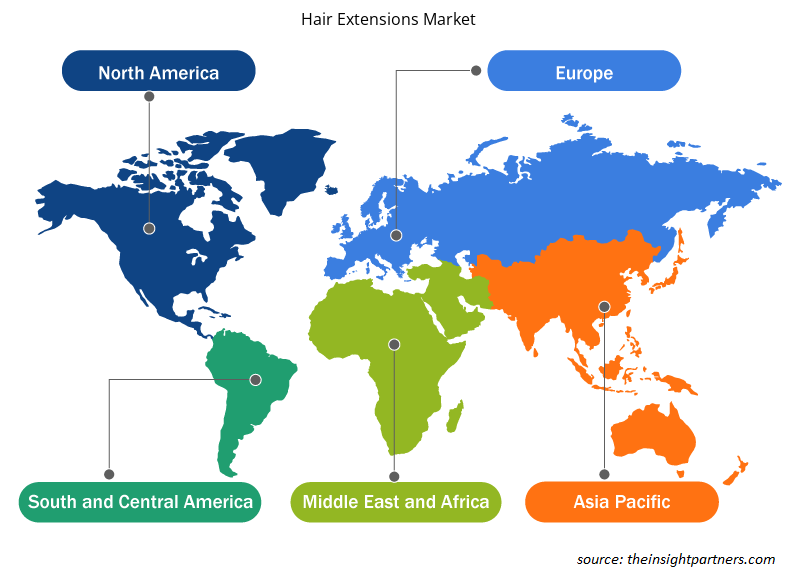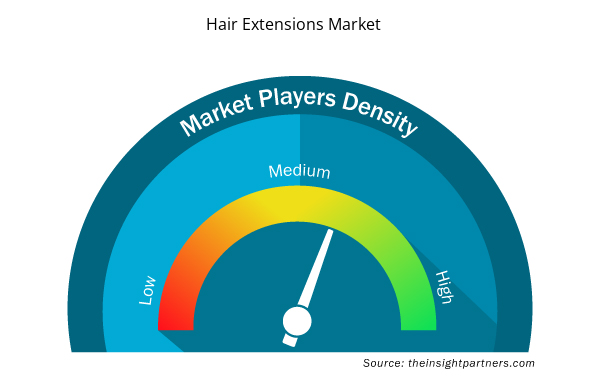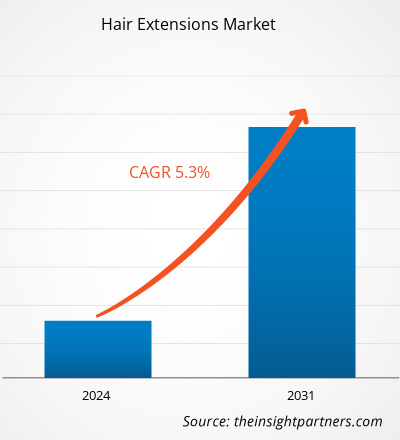The hair extensions market size is projected to reach US$ 6.00 billion by 2031 from US$ 3.98 billion in 2023. The market is expected to register a CAGR of 5.3% during 2023–2031. Increasing promotion of hair extensions on social media platforms with integrated shopping facilities and brand endorsements on Instagram, Facebook, and YouTube are likely to bring in new trends in the hair extensions market
Hair Extensions Market Analysis
A gradual consumer shift toward premium and luxury self-grooming products, positive effects of personal care on self-esteem and social interaction, improvement in quality of life, and rising incidence of hair fall propel the growth of the hair extension market. Rising demand for hair extensions in the fashion and entertainment industries due to the increasing preference for hair extensions among models and celebrities is projected to open potential opportunities for the market in the coming years.
Hair Extensions Market Overview
Hair extensions are mainly made of human hair or synthetic hair of varying length, volume, and color. These are customizable to suit the customers' requirements and are further styled by a hairdresser. While clamping hair extensions, the original hair texture is not disturbed. These offer a quick solution to add volume and make the hair look longer and fuller without the need to undergo a painful hair transplant procedure. Thus, with rising disposable income and improving living standards, coupled with the booming fashion retail sector, the hair extension market is expected to continue to flourish in the upcoming years.
Customize This Report To Suit Your Requirement
You will get customization on any report - free of charge - including parts of this report, or country-level analysis, Excel Data pack, as well as avail great offers and discounts for start-ups & universities
Hair Extensions Market: Strategic Insights

- Get Top Key Market Trends of this report.This FREE sample will include data analysis, ranging from market trends to estimates and forecasts.
You will get customization on any report - free of charge - including parts of this report, or country-level analysis, Excel Data pack, as well as avail great offers and discounts for start-ups & universities
Hair Extensions Market: Strategic Insights

- Get Top Key Market Trends of this report.This FREE sample will include data analysis, ranging from market trends to estimates and forecasts.
Hair Extensions Market Drivers and Opportunities
Rising Adoption of Self-Grooming Products to Favor Market
The global hair extension market is experiencing steady growth, primarily fueled by shifting consumer preferences toward luxury and premium self-grooming products. This trend is largely driven by rising disposable incomes, greater purchasing power, and an increasing focus on personal appearance as a reflection of lifestyle and social identity. Consumers are now more willing to invest in high-quality grooming solutions, including hair extensions, which offer versatility, aesthetic enhancement, and convenience. A growing number of individuals are seeking effective ways to address common hair-related concerns such as hair thinning, dryness, reduced volume, and hair loss. As these issues become more prevalent across demographics, demand for hair care solutions—particularly those that offer instant transformation like hair extensions—is on the rise. Innovations in extension materials, application techniques, and durability have further elevated product appeal across consumer segments. Europe and North America collectively account for over 60% of the global cosmetics and personal care market, making them pivotal regions for the styling industry. Consumers in these regions continue to adopt hair extensions not only as cosmetic enhancements but also as tools for experimenting with styles, colors, and textures without committing to permanent changes. Notably, consumers of African descent represent a particularly influential segment within the hair extension market. Research indicates that African women are willing to spend up to twice as much on beauty and hair products compared to other demographics. This cultural and economic commitment to hair care has significantly contributed to the market’s expansion. High demand for protective styles, lengthening options, and volume-boosting products underscores the importance of hair extensions in their grooming routines. Additionally, the rising visibility of beauty influencers, celebrity endorsements, and social media marketing has further propelled consumer awareness and normalized the use of hair extensions across diverse age groups and regions. As beauty standards continue to evolve globally, the demand for personalized, premium, and convenient hair enhancement solutions is expected to drive continued growth in the hair extension market.
Growing Utilization of Hair Extension in Entertainment and Fashion Industries
Hair extension are highly adopted in the entertainment and fashion industries owing to the rising incidence of alopecia. Further, the demand for hair extensions in countries such as the US is mainly determined by celebrity trends. This factor influences the general population, and more people are demanding hair extension products. Recently, Sunny's Hair & Wigs, a retail store, has expanded to Phoenix and Atlanta since it started in Minneapolis in 1992. It has a vast client base in the entertainment industry.
The fashion and entertainment industries have become vital for the sale and adoption of hair extension products. Production and fashion houses stock numerous hair extensions for models and actors since they perform distinguished roles and characters. The upsurge in hair ailments among consumers is also assisting the industry to grow at a uniform pace. The number of individuals suffering from hair fall is increasing rapidly, owing to which several people are choosing hair extensions. Thus, such factors are expected to create lucrative opportunities for the growth of the hair extension market during the forecast period.
Hair Extensions Market Report Segmentation Analysis
Key segments that contributed to the derivation of the hair extensions market analysis are type, source, and distribution channel.
- Based on type, the hair extensions market is segmented into tape-in, fusion and pre-bonded, clip-in, weft, and others. The clip-in segment held the largest market share in 2023. Clip-in hair extensions, also called clip-in wefts, are ready to use products and are the least permanent extensions as these can be easily removed and applied whenever needed. Clip-in hair extension usually takes 5–15 minutes to apply at home. These are the least damaging hair extensions and do not have chemicals, pressure, heat, or other installation methods. Therefore, benefits such as easy application of clip-in hair extensions and less damage to the natural hair propel the demand for clip-in hair extensions.
- By source, the market is bifurcated into human hair and synthetic hair. The synthetic hair segment held a larger share of the market in 2023. Synthetic hair extensions are cheaper than human hair extensions, which is anticipated to drive the demand for synthetic hair extensions. In addition, the availability of a wide variety of colors, styles, and lengths; requirement of low maintenance; and less application time of synthetic hair extensions fuel their demand.
- In terms of distribution channels, the market is segmented into supermarkets and hypermarkets, specialty stores, online retail, and others. The specialty stores segment held a significant share of the market in 2023. Specialty stores have hair extension experts and offer personalized services. Hair extension specialists in the stores are trained to assess individual needs, recommend suitable products, and provide professional installation and maintenance services. This level of expertise instills customer confidence, ensuring a better outcome and reducing the risk of damage or incorrect application.
Hair Extensions Market Share Analysis by Geography
The geographic scope of the hair extensions market report is mainly divided into five regions: North America, Asia Pacific, Europe, the Middle East & Africa, and South & Central America.
North America dominated the hair extension market in 2023. The demand for hair extensions in North America has surged due to growing celebrity fashion trends and elevated grooming and beauty activities. Caucasian consumers usually use hair products for cosmetic reasons or to create a specific fashion image. Caucasian consumers are mainly from North America and Europe and generally hold higher incomes than customers in other regions. They also pay more attention to the quality of their hair products, which surges the demand for human hair goods. Increasing hair loss is another major factor that boosts the hair extension market growth. Consumers in North America mainly focus on using advanced forms of hair extensions. Manufacturers in the region are investing heavily in the research and development of hair extensions, which is expected to boost its market in North America. In the past 15 years, Cinderella Hair has been at the forefront of the pre-bonded hair extension innovation, providing the finest cuticle 100% Remy human hair.
Hair Extensions Market Regional Insights
The regional trends and factors influencing the Hair Extensions Market throughout the forecast period have been thoroughly explained by the analysts at Insight Partners. This section also discusses Hair Extensions Market segments and geography across North America, Europe, Asia Pacific, Middle East and Africa, and South and Central America.

- Get the Regional Specific Data for Hair Extensions Market
Hair Extensions Market Report Scope
| Report Attribute | Details |
|---|---|
| Market size in 2023 | US$ 3.98 Billion |
| Market Size by 2031 | US$ 6.00 Billion |
| Global CAGR (2023 - 2031) | 5.3% |
| Historical Data | 2021-2022 |
| Forecast period | 2024-2031 |
| Segments Covered |
By Product Type
|
| Regions and Countries Covered | North America
|
| Market leaders and key company profiles |
Hair Extensions Market Players Density: Understanding Its Impact on Business Dynamics
The Hair Extensions Market is growing rapidly, driven by increasing end-user demand due to factors such as evolving consumer preferences, technological advancements, and greater awareness of the product's benefits. As demand rises, businesses are expanding their offerings, innovating to meet consumer needs, and capitalizing on emerging trends, which further fuels market growth.
Market players density refers to the distribution of firms or companies operating within a particular market or industry. It indicates how many competitors (market players) are present in a given market space relative to its size or total market value.
Major Companies operating in the Hair Extensions Market are:
- Locks & Bonds
- Klix Hair Inc
- Easihair Pro.
- Balmain Hair Group BV
- Great Lengths SpA
- Evergreen Products Group Ltd
Disclaimer: The companies listed above are not ranked in any particular order.

- Get the Hair Extensions Market top key players overview
Hair Extensions Market News and Recent Developments
The hair extensions market is evaluated by gathering qualitative and quantitative data post primary and secondary research, which includes important corporate publications, association data, and databases. A few of the developments in the hair extensions market are listed below:
- Diva Divine Hair, India's first premium retailer of hair extensions and wigs since 2008, launched a new range of pocket-friendly and premium quality products such as Clip-in Hair Extensions, Hair Toppers, Wigs, and Hair Accessories. The products offered by Diva Divine are made of 100% natural human hair. The company revealed that their Clip-In Hair Extensions are easy to use and provide instant hair length and volume. It also mentioned that their Hair Toppers are available in various shapes and sizes, and Wigs are easy to apply and gives a natural look. (Source: Hindustan Times, Newsletter, July 2022)
- Hair extensions company Bellami launched Bellami Professional Hair Care, the world’s first professional-grade hair extension care collection for in-salon and at-home use. (Happi, Newsletter, October 2023)
Hair Extensions Market Report Coverage and Deliverables
The “Hair Extensions Market Size and Forecast (2020–2031)” report provides a detailed analysis of the market covering below areas:
- Hair extensions market size and forecast at global, regional, and country levels for all the key market segments covered under the scope
- Hair extensions market trends as well as market dynamics such as drivers, restraints, and key opportunities
- Detailed PEST/Porter’s Five Forces and SWOT analysis
- Hair extensions market analysis covering key market trends, global and regional framework, major players, regulations, and recent market developmentsIndustry landscape and competition analysis covering market concentration, heat map analysis, prominent players, and recent developments for the hair extensions market
- Detailed company profiles
- Historical Analysis (2 Years), Base Year, Forecast (7 Years) with CAGR
- PEST and SWOT Analysis
- Market Size Value / Volume - Global, Regional, Country
- Industry and Competitive Landscape
- Excel Dataset



Report Coverage
Revenue forecast, Company Analysis, Industry landscape, Growth factors, and Trends

Segment Covered
Product Type, Source, and Distribution Channel

Regional Scope
North America, Europe, Asia Pacific, Middle East & Africa, South & Central America

Country Scope
Argentina, Australia, Brazil, Canada, China, France, Germany, India, Italy, Japan, Mexico, Russian Federation, Saudi Arabia, South Africa, South Korea, United Arab Emirates, United Kingdom, United States
Frequently Asked Questions
Which region dominated the hair extensions market in 2023?
North America dominated the market in 2023 owing to the rising influence of social media trends and celebrities on people’s lifestyles.
What are the future trends of the hair extensions market?
Increased promotion of hair extensions on social media platforms is one of the key trends in the market.
What are the driving factors impacting the hair extensions market?
Rising adoption of self-grooming products, increasing disposable income, and growing middle-class population are among the key market drivers.
Which are the leading players operating in the hair extensions market?
Locks & Bonds, Klix Hair Inc, Easihair Pro., Balmain Hair Group BV, Great Lengths SpA, Evergreen Products Group Ltd, Socap USA Inc., Cinderellahair Inc., Barclay Wolf Ltd, and Hairlocs Inc are a few of the players operating in the global hair extension market.
What is the expected CAGR of the hair extensions market?
The market is expected to register a CAGR of 5.3%.
What would be the estimated value of the hair extensions market by 2031?
By 2031, the hair extensions market is projected to reach US$ 6 billion.
Trends and growth analysis reports related to Consumer Goods : READ MORE..
The List of Companies - Hair Extensions Market
- Locks & Bonds
- Klix Hair Inc
- Easihair Pro.
- Balmain Hair Group BV
- Great Lengths SpA
- Evergreen Products Group Ltd
- Socap USA Inc.
- Cinderellahair Inc
- Barclay Wolf Ltd
- Hairlocs Inc.

 Get Free Sample For
Get Free Sample For